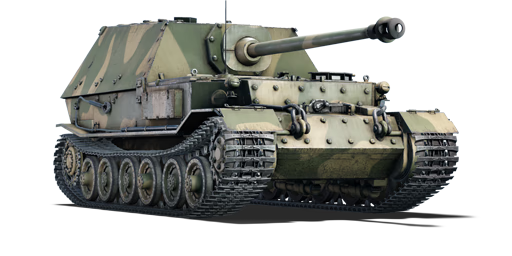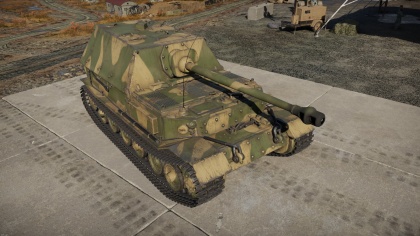Ferdinand
Contents
Description
The Panzerjäger Tiger (P) Ferdinand is a rank German tank destroyer
with a battle rating of (AB), (RB), and (SB). This vehicle was introduced during the Closed Beta Test for Ground Forces before Update 1.41.
General info
Survivability and armour
Describe armour protection. Note the most well protected and key weak areas. Appreciate the layout of modules as well as the number and location of crew members. Is the level of armour protection sufficient, is the placement of modules helpful for survival in combat?
If necessary use a visual template to indicate the most secure and weak zones of the armour.
Mobility
Write about the mobility of the ground vehicle. Estimate the specific power and manoeuvrability as well as the maximum speed forward and backward.
Armaments
Main armament
During the development of the two models of the Tiger tank by Porsche and Henschel, Hitler had excitedly demanded a tower design which was big enough to incorporate the 8.8cm KwK L / 17. This could not be implemented and so it was decided on September 22, 1942 to develop an assault gun with 200 mm frontal armor and the long 8.8 cm cannon on the chassis of the Tiger (P) immediately and part of the Porsche Tiger Production was diverted for this vehicle.
Porsche lost to the company Henschel with the development of its too complicated and error-prone design of the Tiger tank. Professor Ferdinand Porsche's influence with Hitler was great, however, as his unusual technical ideas on the Führer had a fascinating effect. So it happened that Porsche was allowed to start on behalf of Hitler with the construction of their own vehicles, so that there were 90 more or less finished chassis, which were then practically unusable.
Only two of the Porsche tigers were completely completed, but suffered from the too complicated technology and were never frontreif. In order to avoid wasting all the other chassis, the heavy Jagdpanzer Elefant was to be created by replacing the unreliable Porsche diesel engines with proven Maybach carburetor engines. The new 8.8-cm Pak43 / 2 anti-tank gun, which was developed from the 8.8-cm Flak 18/37, should serve as an armament.
The company Alkett was chosen to design and build this tank destroyer 'Ferdinand' (after Professor Dr. Ferdinand Porsche, as mockery of the troupe on its unspeakable design), while the Nibelungenwerke should deliver the complete chassis.
Despite a lack of parts for the chain suspension and lack of trial runs, Hitler ordered on 6 February 1943, 90 Jagdpanzer Ferdinand as soon as possible and under all circumstances to build for use at the front. This led to the fact that the Nibelungen works instead of Alkett completely produced by Hitler as Jagdpanzer 'Elephant' vehicle.
All 90 vehicles were ready by the end of May 1943 to be used for the great summer offensive in the Kursk Battle, along with the Tiger tanks and the new PzKpfw V Panther also scheduled for this date.
The tank of the Jagdpanzer Elephant was the one of the Tiger (P), however, additional 100mm armor plates were riveted to the front, and an additional rear part to support the superstructure and to mount bleeders for the cooling air of the rearmost electric motor.
Within the superstructure was the long 8.8 cm cannon with a limited straightening area. The Tiger's (P) combat room, originally set up in the middle, was not suited to hold the long cannon with 50 rounds of ammunition. Therefore, the tank had to be fundamentally changed, with the two new engines were relocated in the middle and the fighting room came to the rear and only at the rear of the electric transmission.
The sides of the box-like structure were bevelled as well as possible and the cannon still protruded 1.22 meters ahead.
A secondary armament was installed only in late 1943, when the vehicles returned from the front were rebuilt and received a machine gun in the front fuselage. The superstructure was changed at the same time to equip the commander with a dome. In this way, 48 Jagdpanzr Elefant were rebuilt and then used in Italy.
The tub was flat like the Tiger tank up and the construction was very spacious. The crew boarded the Jagdpanzer through a large, round hatch on the back. Otherwise, there were virtually no openings in the strong armor and all joints overlapped and were welded.
Steel rims were used for the wheels of the track drive, which led to some suspension and a quiet ride. Therefore, support rollers were not necessary and the front idler was mounted slightly higher so that the vehicle could better climb over obstacles.
The two Maybach engines gave their power to a Siemens Suchert dynamo, which powered the two electric motors behind, which in turn moved the drive wheels. The control had to be supported by hydraulic motors, but no gearshift was necessary, which made the work easier for the driver.
Innerhalb des Überbaus befand sich die lange 8,8-cm-Kanone mit begrenztem Richtbereich. Der ursprünglich in der Mitte angelegte Kampfraum des Tiger(P) war nicht geeignet, die lange Kanone mit 50 Schuss Munition aufzunehmen. Deshalb mußte der Panzer grundlegend verändert werden, wobei die beiden neuen Motoren in die Mitte verlegt wurden und der Kampfraum nach hinten kam und erst ganz hinten das Elektrogetriebe.
Die Seiten des kastenförmigen Aufbaus wurden so gut wie möglich abgeschrägt und die Kanone ragte trotz allem immer noch 1,22 Meter vorne über.
Eine Sekundärbewaffnung wurde erst Ende 1943 eingebaut, als die von der Front zurückgekehrten Fahrzeuge umgebaut wurden und ein Maschinengewehr im vorderen Rumpf erhielten. Der Überbau wurde zur gleichen Zeit verändert, um den Kommandanten mit einer Kuppel auszustatten. Auf diese Weise wurden 48 Jagdpanzr Elefant umgebaut und anschließend in Italien eingesetzt.
Die Wanne war wie beim Tiger-Panzer oben flach und der Aufbau war sehr geräumig. Die Mannschaft stieg in den Jagdpanzer durch eine große, runde Luke auf der Rückseite ein. Sonst gab es praktisch kaum Öffnungen in der starken Panzerung und alle Stoßstellen überlappten und waren verschweißt.
Stahlfelgen wurden für die Laufrollen des Kettenlaufwerks verwendet, was zu etwas Federung und einer ruhigen Fahrt führte. Deshalb waren Stützrollen nicht notwendig und das vordere Leitrad war etwas höher angebracht, damit das Fahrzeug besser über Hindernisse klettern konnte.
Die beiden Maybach-Motoren gaben ihre Kraft an einen Siemens-Suchert-Dynamo weiter, der die beiden hinten liegenden Elektromotoren mit Strom versorgte, welche wiederum die Triebräder bewegten. Die Steuerung mußte noch durch Hydraulikmotoren unterstützt werden, allerdings war keine Gangschaltung notwendig, was die Arbeit für den Fahrer einfacher machte.
{{main|Name of the weapon}}. Describe in general terms the ammunition available for the main gun. Give advice on how to use them and how to fill the ammunition storage.
Additional armament
Some tanks are armed with several guns in one or more turrets. Evaluate the additional weaponry and give advice on its use. Describe the ammunition available for additional weaponry. Give advice on how to use them and how to fill the ammunition storage. If there is no additional weaponry remove this subsection.
Machine guns
Offensive and anti-aircraft machine guns not only allow you to fight some aircraft, but also are effective against lightly armoured vehicles. Evaluate machine guns and give recommendations on its use.
Usage in battles
The "Jagdpanzer Elefant" is in Battle like a "Bunker" with Chain drive. It is very hard to attack with this Vehicle. The best Way to use it is, take cover behind a Buildung where you cant get shot from the Side, and then cover a Sector.
Try to hide your Gun Barrel! It is most important to stay in Battle with an working Gun. If your Gun gets shot, the Enemy will Push you to Death.
Pros and cons
Pros:
- The armour is 200 mm thick on the front of the tank very few tanks can penetrate it
- Powerful 88 mm Pak gun with two loaders makes it able to destroy multiple targets in a short time
- Thanks to the transmission, Ferdinand can go backward as fast as it can go forward
- The transmission is in the back of the tank
- Good natural steering
- Good optics for sniping
- 6 crew members make it difficult for opponents to knock it out
- The Ferdinand can fire over high obstacles without problem
Cons:
- The tank loses speed and momentum when turning
- The hull's thin cheek armour's effectiveness decreases when angling
- The front armour is not angled
- Slow due to its heavy weight
History
Story behind the Scenes:
The Jagdpanzer Elephant were assigned to the Heavy Tank Hunters Departments 653 and 654 in April and May 1943. These units fought at Kursk during the short German offensive and later in summer and autumn helped to fill in front gaps in this section of the Eastern Front.
It was noticeable that the elephant was dispatched in a hurry before any technical problems were resolved and the crews had enough time to familiarize themselves with the vehicles. As soon as the elephants attacked, many were left with technical failures.
Nevertheless, during the Panzer Battle of Kursk, the two Panzerjäger divisions successfully led the first attack and broke through the Soviet lines of defense. Although the vehicles were armed with the strongest available cannon, they had not received self-defense weapons. Thus, Soviet infantry could put many of them in the rear lines out of action because their crews could not defend.
The advantage of the Jagdpanzer Elephant lay in its large cannon and thick armor, so that it could fight enemy tanks at very long distances, while it was itself invulnerable against any frontal fire.
But this advantage was associated with extremely high ground pressure, so that the vehicle easily stuck in difficult terrain. Therefore roads, paths and terrain had to be explored before the march or combat mission.
However, when used as 'mobile bunkers' in defense, they were successful.
The two units were pulled from the front line in late 1943 to overtake the vehicles. Subsequently, only the 653rd Panzerjäger Abteilung was re-equipped with the converted vehicles and a separate company assigned to the 614th Panzerjäger Abteilung.
The Panzerjäger Elefant could not fix its bad reputation from the catastrophic debut at Kursk but the remaining vehicles were used in 1944 in Italy. The lack of spare parts, its size, technical unreliability and immobility led to numerous failures and some were also captured by Allied troops.
Media
An excellent addition to the article will be video guides, as well as screenshots from the game and photos.
See also
Links to the articles on the War Thunder Wiki that you think will be useful for the reader, for example:
- reference to the series of the vehicles;
- links to approximate analogues of other nations and research trees.
External links
Paste links to sources and external resources, such as:
- topic on the official game forum;
- encyclopedia page on tank;
- other literature.
| Germany tank destroyers | |
|---|---|
| Pz. I Derivatives | Panzerjäger I |
| Pz. II Derivatives | 15cm sIG 33 B Sfl |
| Pz. 38(t) Derivatives | Marder III · Marder III H · Jagdpanzer 38(t) |
| Pz. III Derivatives | StuG III A · StuG III F · StuG III G · StuH 42 G |
| Pz. IV Derivatives | Jagdpanzer IV · Panzer IV/70(A) · Panzer IV/70(V) · Dicker Max · Nashorn · Brummbär · VFW |
| Pz. V Derivatives | Jagdpanther G1 · Bfw. Jagdpanther G1 |
| Pz. VI Derivatives | Sturer Emil · Elefant · Ferdinand · 38 cm Sturmmörser · Jagdtiger |
| Wheeled/Half-track | 8,8 cm Flak 37 Sfl. · Sd.Kfz.251/9 · Sd.Kfz.251/10 · Sd.Kfz.251/22 · Sd.Kfz.234/3 · Sd.Kfz.234/4 · 15 cm Pz.W.42 |
| ATGM Carrier | RakJPz 2 · RakJPz 2 (HOT) · Wiesel 1A2 |
| Other | Waffenträger · M109G · JPz 4-5 · Raketenautomat · VT1-2 |





